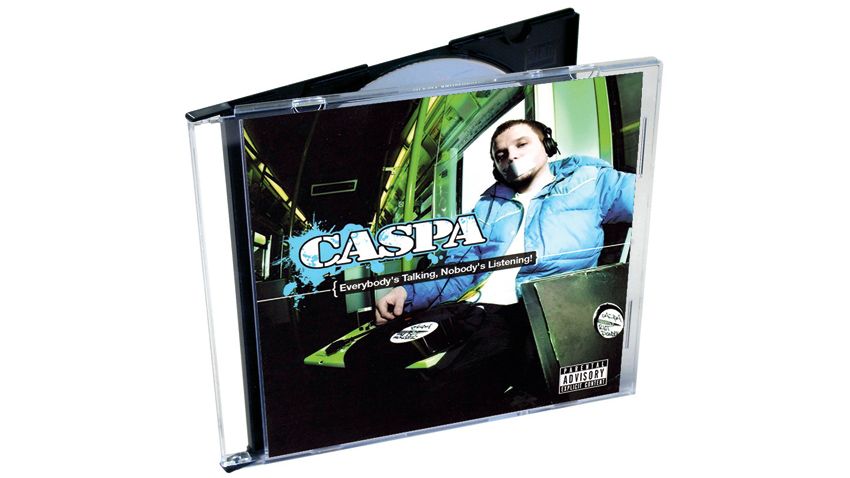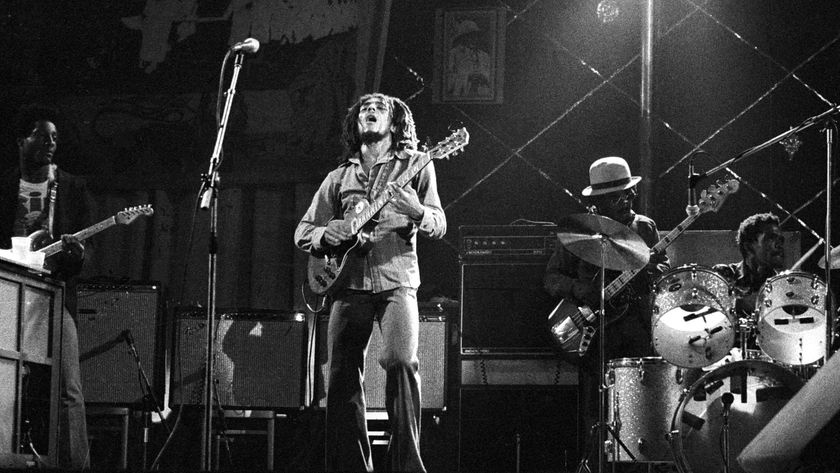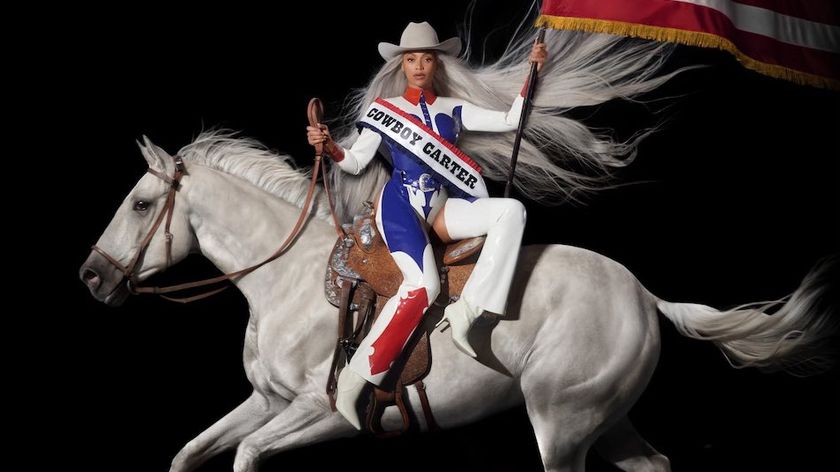Classic album: Caspa on Everybody’s Talking, Nobody’s Listening!
The dubstep doyen looks back over his 2009 gamechanger

From the moment UK reggae legend David Rodigan, bathed in reverb and echo, asks, “Are you listening? Because Caspa’s playing,” on the album’s intro, you know you’d better pin back those lugs. What follows is a right earful of dubstep. It’s the sound of late 2000’s West London. But via 90s jungle, Houston ‘screwed & chopped’ music, a bit of Only Fools and Horses, and a lot of doing whatever he wanted.
“It was still an ‘anything goes’ time for dubstep,” says Caspa. “Not a lot of albums were floating around, not a lot of compilations. I knew people would look at it and judge it, going, ‘So, this is dubstep?’ I wanted to show people what it was about.”
For Caspa, it was about showing you how deep it could go (Low Blow), how banging it could be (Marmite), how cheeky it was (Disco Jaws), and how much it owed a debt to the club styles that preceded it (Back To ’93).
After the album dropped, he was dubstep’s new ambassador, and everyone was listening. From the sell-out crowds at LA’s historic House of Blues, to his roadblock album launch party at Fabric.
“It was like a virus,” he says, “It just went mad. I couldn’t play enough shows. I could have played seven days a week for, like, three years, I reckon. It just went absolutely crazy.
“It took me to the other side of the pond. All that early heavy wobble kind of sound just went off.”
It even caught the ears of a certain global yeast extract brand.
Get the MusicRadar Newsletter
Want all the hottest music and gear news, reviews, deals, features and more, direct to your inbox? Sign up here.
“Marmite hit me up after the album came out and said, ‘We hear you have a tune called Marmite. We’d love you to do something with us and be a music ambassador’.
“I was like, ‘Fuck that! That’s not what I do. I make dubstep. I don’t do fucking adverts for Marmite’.
“My dad was saying I was crazy! I could have been rich. I said, ‘Dad! I don’t do it for the money!’ [laughs].”
Caspa’s latest release is the Ghost Town EP, which is out now on Bassrush Records.

Intro
“That was crazy, to get [UK reggae legend] David Rodigan on this. He narrated my intro.
“He had two sons, one who was a dubstep head. He’d tell his dad about the music, so Rodigan had an idea what was going on.
“I got his number and we spoke on the phone for maybe an hour and a half, talking about music and stories from way back in the day.
“He recorded his vocals in the Kiss FM studios, where he did his radio show. He sent me five or six things, doing characters, like policemen and cricket commentators, and he let me choose.
“To be blessed by Rodigan made a lot of people think, ‘Wow. Fuck. That’s Rodigan’. Your granddad knows who Rodigan is.
“If you’ve got him on your album, then the album is already certified.”
Low Blow
“I wanted to come in with something low and heavy and almost stripped-back, like early dubstep. Like, ‘Here we go. The sound of how it all started’.
“It’s a kick and a snare and lots of sub. You won’t understand it in your headphones, but when you get in a club you’ll be like, ‘Oh fucking hell!’.
“I didn’t just want ten tunes of smashers. It wasn’t just dancefloor hits. It comes from people like Mala and Burial. That’s dubstep, too. I wanted the album to have a bit of everything that was going on in our scene.”
The Takeover
“The track came about after I went to Houston, around 2008, and they had a music out there called ‘screwed & chopped’. I said to the guy looking after me, ‘Take me to the shop where everyone goes to get their mix CDs’. And we went to the mall and I said to the guy behind the counter, ‘I’m from the UK. I wanna know what screwed & chopped is. Give me the hardest CD you’ve got’.
“He gave me something by Swishahouse. I think it was a Michael ‘5000’ Watts mix CD. It had everyone on. I remember thinking, ‘Fuck! It sounds so much like dubstep’. It was really low and slow. I went away knowing I wanted to make a dubstep tune influenced by this. tyout
“Dynamite MC heard it, wrote to it and bang! That’s it.”
Marmite
“I needed a banger. I was listening to a DJ Hazard mix CD, and I heard a bit in there with a live MC called MC Fatman D yelling, ‘all the people out to have a FUCKIN’ good time, say YEAH!’, so tried to flip that and added some drums.
“Then I kinda went for the bassline style I used on my Where’s My Money? remix. Just a real fast and wobbly sound. It sounded a bit… fucked.
“I just wanted to make a tune that would tear up a dancefloor, and that was it. There was no, ‘Alright. Let’s make something deep and emotional’. Nah. Let’s just make a fucking cracker. That’s what Marmite was.”
Riot Powder (Intro)
“This has Rod Azlan on here. He was our MC on the road with me and Rusko. He hosted. He was great. He wasn’t your typical ‘pre-nommy-nah-pre-nomm-a-nah’ kind of MC. He was very roots and reggae vibing and let the music talk kinda guy. He’d chat ‘my old man’s a dustman’, but in a reggae style. Just really funny.
“I really wanted him on the album, so he did one of his chats that he always did at the shows, which was a perfect lead in for the Riot Powder tune.”
Riot Powder
“The title of the tune came from a hooligan film, and it was this mad drug that these Dutch football hooligans took before a game. I tried to make a tune that had the energy of that, what they must be feeling. It was about adrenaline and that kind of mentality.
“With the bass, I’d have a sub and then layer over a distorted top to create that high and low energy. I always found it hard back then to create that mono sub that I was going for, but with that real stereo brightness at the top. Sometimes the sub sounded nice in stereo, though.
“I would generally have 808s underneath, then add some Maelstrom crazy bass sounds up the top.”
The title of the tune came from a hooligan film, and it was this mad drug that these Dutch football hooligans took before a game. I tried to make a tune that had the energy of that, what they must be feeling.
Lon-Don City
“I’d been listening to a lot of soulful music and old-skool 90s slow jams - people like H-Town - so made a beat like that.
“Then I got Uncle Sam on it. He was a white guy from Florida, and played in the Caribbean quite a lot as a reggae artist.
“I made something just floaty and dreamy, and laid back. I sent him the beat and told him what I wanted.
“When it came back, it was exactly like what I’d tried to explain to him in the emails. He nailed it.
“It wasn’t going to go on the album. It’s not really dubstep, is it? It’s different.”
The Terminator
“This was a track that was made in January 2007. It went on the Fabric mix. People just seemed to love that tune. Looking back at it now, it’s completely out of key! It’s funny. That was the thing back then. It was like, ‘That’s alright. Sounds alright. Keep that’. That was how I lived.
“Looking back now, I’m like, ‘What were you doing?!’ But that was the charm of it. That’s why it was punk. Who cares if it was off? Who knew dubstep would get this big, or where it would get to? We were just having a bit of fun.”
Rat-A-Tat Tat
“This was an instrumental for Shy FX’s label called ‘My Pet Monster’, originally. I sent a bunch of tunes to Dynamite MC and he vocalled this. I wasn’t really looking for a vocal on this, but it was so sick.
“He was so unselfish. He’s all about how he could move with the track and keep that flow going and not be the main event.
“I turned his vocals down an octave on the end of his verses - that was another influence I took from screwed & chopped. Some of that stuff was out of key, but it sounded good.”

Victoria’s Secret
“This has D1 on. He was signed to Tempa the same time as Skream and Benga. He lived in Fulham, so was a West London guy too. This was pre me signing him to my label, Dub Police. He was very musical. I played him the loop of this and he really liked it and asked to play some chords and a bassline for it.
“The vocal is my ex-girlfriend [laughs]. By the time of the album I had a new missus. I loved the tune so said to her, ‘Look. It’s gotta go on the album’. She was like, ‘Whatever’, which was cool.”
I Beat My Robot
“This track was pretty much made for the dancefloor. It was something I worked on just for the album. I wanted something industrial-sounding and very choppy, and roboty.
“I didn’t think this one would be a massive hit and people would love it. I thought it would be more of a filler tune, but it ended up being a really popular tune and going on the vinyl with Marmite.
“It did well in the States. This was pre-EDM. It was heavy and hard. The American market loved it. If you listen to it, you get that early start of that very heavy dubstep sound. Quite choppy with lots of FX popping in and out. It was crazy how America picked it up.”
This track was pretty much made for the dancefloor. It was something I worked on just for the album. I wanted something industrial-sounding and very choppy, and roboty.
Disco Jaws
“I’d always have these guys and girls coming up to me, chewing their fucking faces off. I’m trying to be polite, but I’d get it all the time. I had to write a track about that. And who better to get on it than Beezy? That’s his style. Very UK, very London, very cheeky [laughs].
“It was very simple, just made on the keyboard, super stripped-back. I told him that we had to talk about people off their nut.
“There’s loads of people from the scene getting called out on there. It was just for fun. I grew up watching Only Fools and Horse, Some Mothers Do ’Ave ’Em and On The Buses.
“I really wanted to do a video for it. Imagine that! It would have been an internet sensation. My manager was like, ‘No!’ [laughs].”
Back To ’93
“1993 - I was maybe 12. I remember seeing the older lot listening to their tapes of One Nation and Telepathy shows on the estate I grew up on. Later on, I got more into it and looked back a lot more.
“I’m not a full jungalist, I’m not gonna lie, but I’m a jungle head for sure. This track was a tribute to that era. More so than anything else, it was LTJ Bukem with Horizons and Atlantis. I thought, ‘Let me make a slowed down, 145, jungle tune, and that’s what it is. Birds tweeting, pads, choirs, 808s, an old-skool break.
“Dubstep was just an evolution of UK music, and I wanted to end the album on that.”
For all the freshest sounds from the UK bass pioneer, head to his Soundcloud page.


Future Music is the number one magazine for today's producers. Packed with technique and technology we'll help you make great new music. All-access artist interviews, in-depth gear reviews, essential production tutorials and much more. Every marvellous monthly edition features reliable reviews of the latest and greatest hardware and software technology and techniques, unparalleled advice, in-depth interviews, sensational free samples and so much more to improve the experience and outcome of your music-making.

"Reggae is more freeform than the blues. But more important, reggae is for everyone": Bob Marley and the Wailers' Catch a Fire, track-by-track

“Part of a beautiful American tradition”: A music theory expert explains the country roots of Beyoncé’s Texas Hold ‘Em, and why it also owes a debt to the blues










